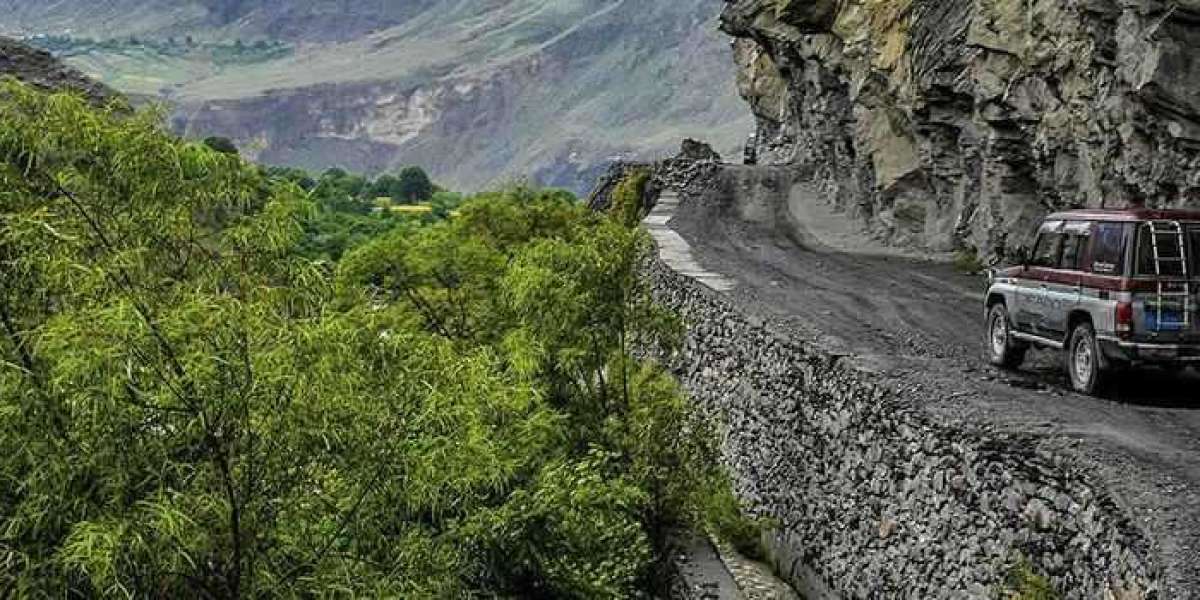One of Pakistan's most fascinating tourist spots is Kalash Valley. This remote region has long been isolated from other areas, creating a vibrant culture with an ancient Hinduism-influenced heritage. You'll find plenty of unique traditions and festivals here that cannot be found elsewhere in Pakistan - make sure you check them out!
The Kalash people are the last survivors of an ancient region that stretched across northwest Pakistan and eastern Afghanistan, once known as Kafiristan. Their region remains relatively unchanged today.
This ethnic group once had a large population, but is now restricted to three valleys: Bubur, Rumbur, and Birir. Rumbur, Bunboret, and Birir form a distinct cultural world apart from Pakistan's majority Muslim population. These valleys lie within Chitral in Pakistan's North-West Frontier Province, near Nuristan in Afghanistan.
Kalash Valley residents are warm and inviting, sure to make you feel right at home. You'll be welcomed with open arms and shown the best of their traditions. However, visitors to this area face several difficulties when traveling. One of the biggest is a lack of suitable roads.
Therefore, Kalash Valley Road is an eagerly anticipated development project which promises to increase tourism in the valley, provide employment for thousands of people and enhance the quality of life for local residents.
Kalasha Valley
Kalash Valley is a remote mountainous region located deep within Khyber Pakhtunkhwa's mountains. It boasts an intriguing culture and traditions, making it a popular tourist destination; however, getting there can be challenging due to the poor road infrastructure.
Kalasha Valley residents are an ethnic group numbering only a few thousand individuals. As such, they form an exclusive minority with their own language, culture, and religion.
Their language, Kalash, belongs to the Dardic group of Indo-Aryan languages and has been recognized by UNESCO as an intangible cultural heritage.
Kalash people remain deeply committed to their religion and revere the god Mahadeo for his protection of both land and domesticated animals. Even though their language is considered endangered, they remain deeply religious.
They also venerate Poh, the goddess of fertility. They celebrate numerous festivals such as Chilam Joshi Festival, Uchal Festival, and Poh Festival annually.
Visitors flock to Kalash Valley each year to witness their festivals. Some of the biggest events include Uchal Festival in summer and Chilam Joshi Festival in spring.
The valley is one of Pakistan's least developed and remote regions, with most people living in its three main valleys: Bumburet, Rumbur, and Birir. Although Kalash communities make up a small minority in these valleys, they still contribute significantly to local economies.
Kalash are an animist tribe with a distinct cultural identity. As minorities in the valleys, they tend to lack educational attainment compared to other groups.
Their community is steadily losing ground due to socio-economic deprivation and pressure from non-Kalash people to convert to Islam. This also prompts Kalash women to marry non-Kalash men and give up their traditional lifestyle.
This has had a detrimental effect on the local economy. Furthermore, it's become increasingly difficult for these individuals to secure employment.
However, the Kalash remain firm in their identity. They are renowned for their vibrant traditions and culture which is evident through music and dance performances. Another challenge faced by the Kalash is their inability to be recognized as a distinct political entity, leading them to feel isolated from society as a whole.
This has caused a variety of issues, such as an absence of economic opportunities. Furthermore, they are exposed to illegal logging and flood risks. Unfortunately, they are often living in abject poverty.
Their livelihoods depend on their forests, which are at risk due to loggers. Furthermore, the Kalash people lack access to medical care and education - two factors that put their well-being in jeopardy.
Kalash Valley Road
Kalash Valley is renowned worldwide for its fascinating culture and traditions. Unfortunately, the region has become a popular tourist destination due to its breathtaking beauty. Unfortunately, the roads within the area are in poor condition, posing challenges both to locals and foreign visitors who come here.
To address this issue, the National Highway Authority (NHA) has begun construction on the Kalash Valley road. This road will link the Chitral district with other parts of Pakistan's southern region and offer easy access for both domestic and foreign tourists alike. At an estimated cost of Rs 4.6 billion, NHA plans on constructing this road while compensating landowners affected by its construction.
Chitral residents have long desired this project, which will not only create employment for 2,000 individuals but also benefit the local economy. AC Chitral Saleem Thaqleen, AC Hafizullah, and project director National Highway Authority Rafiq Alam attended to inaugurate construction work.
According to the NHA, this road will be 46km in length with nine bridges, culverts, a shoulder, and a drainage system installed. With a width of 11 meters, it should be completed by September of this year.
At one point, the road was narrow and dilapidated, making it difficult for visitors to travel on. It took more than nine hours to cover a distance of 22 kilometers - an unpleasant experience for those visiting the region.
Furthermore, some wooden bridges on the road were unsafe for vehicles. Authorities must ensure the road is secure and repair it promptly.
There are a few ways to get to the Kalash Valleys, but the most convenient option is hiring a private car and driver. This option may be ideal for those who want to save time as they can cover all the valleys within one day.
The Kalash Valley Road Is Dangerous
Kalash Valley is one of Pakistan's most picturesque and remote places, encased by the Hindukush mountains and home to an intriguing culture and language. Situated within Khyber Pakhtunkhwa's Chitral district, this picturesque valley can be enjoyed year-round.
Traveling to this region is a great idea, as it boasts many historical sights and exciting activities for visitors to enjoy. There are various accommodation options available in the region; some of the most popular being guesthouses and homestays.
From Chitral to the Kalash Valleys, you have two options for transport: hire a car or jeep. Prices will depend on which option you select but typically range between 1,000 - 1200 rupees per person.
Tourists in the valleys should be aware that there are some restrictions on movement. Foreign travelers used to be assigned police escorts upon entering any of the valleys, but this practice has since been discontinued. Therefore, visitors are advised to inform hotel or guesthouse staff beforehand about their plans so that their trip is secure and hassle-free.
How To Reach Kalash Valley?
Kalash Valley, situated in Khyber Pakhtunkhwa's Hindu Kush Mountain range, is home to an extraordinary culture and way of life. It also draws thousands of travelers from around the world annually for its festivals that draw in thousands.
Traveling to Kalash Valley may seem daunting at first, but it's worth every effort. This area boasts stunning scenery, dramatic landscapes, and captivating villages that will surely leave you wanting to stay for as long as possible. You will be treated like royalty here and will want to stay as long as possible to take in all that this stunning valley has to offer.
If you are planning a tour through the Kalash valleys, it is wise to make a reservation beforehand. You can do this via phone, email, or at the tourist office in Chitral.
Once your reservation is confirmed, you can expect to pay around 1,000 to 1,200 RS for a private hire car. Alternatively, you could opt for shared transport or minibuses which will cost less.
No other way to reach the Kalash Valleys than with a 4x4. The roads are unmarked and can be bumpy; without fences on either side, it could prove hazardous for drivers to venture forth.
Traveling by car to the Kalash valleys generally takes two hours, though it could take longer if you are traveling during winter or summer when roads are in poor condition with lots of bumps.
Be prepared for a long, winding drive through Kalash Valleys; oftentimes the road can be impassable. A wise tip would be to book a rental car or jeep before venturing out on this adventurous journey.
Another essential thing to remember is not to take photos of the Kalash people without their consent. Doing so would be highly disrespectful toward them. While they are generally friendly and will welcome visitors into their valleys, remember to treat them as individuals rather than objects.
Before embarking on a trip to Kalash Valley, you must have an extensive understanding of the language and culture. If you do not speak the language fluently, hiring a guide or translator may be best.
Kalash Valley residents are renowned for their friendliness, and you will be warmly welcomed with open arms. They are eager to show you around and provide insights into their culture and customs.
If you're not a fluent language speaker, hiring a tour guide might be best. They will take you on an interesting tour of the valley and point out all key landmarks and cultural aspects. This is an excellent opportunity to learn more about its history as well as get an insider's view of what makes it such an incredible place.
Start your journey to the Kalash Valley from Chitral, a stunning little town that has been an important stopover for local tourism for centuries. If you require food or accommodation before continuing with your journey, Chitral makes for a convenient stopover.
On the way to the valley, you'll get stunning views of the Hindu Kush mountains. There are numerous high peaks to admire and if you're lucky, you may even spot part of the Rakaposhi massif!
Cost
Kalash Valley, situated in the Chitral district's northern region, has become renowned for its distinctive culture and traditions. While the road to get there can be rough and difficult to navigate, the National Highway Authority (NHA) has recently resumed construction work on a 46-kilometer road from Ayun to Bumburet that will save countless hours of travel time for both domestic and foreign visitors alike.
According to the NHA, the new road will cost 4.6 billion rupees and be inaugurated by Deputy Commissioner Lower Chitral Anwarul Haq. He noted that it would improve connectivity within the Valley and its nearby villages.
The road will also assist in the promotion of tourism. Already, several international organizations and tour operators are offering tours to the region. If you're in search of a package deal from Ayun to Chitral, there are plenty of options that include transport from Ayun, accommodation, and food. You can book this service through any hotel in Chitral or online.
Private jeeps typically cost 6,000-7,000 PKR, but you can get better deals if you plan ahead and negotiate with drivers. The fare will be shared among passengers so if you're traveling with friends or fellow travelers, expect to pay less per person.
When visiting the valleys, make sure to stay at a local guest house or homestay. Not only are these an excellent way to support the local community while you're here, but they will allow you to experience life in the valleys from an authentic perspective.
You can hire a local guide to show you around. They will assist in seeing all the major attractions and providing insight into its history. The valleys offer a captivating experience for visitors and can be an incredibly rewarding one.
However, it's best to avoid the tourist traps and instead spend your time admiring nature, connecting with locals, learning about their culture, and enjoying yourself responsibly.
Although, if you're visiting during a festival, there will likely be plenty of official attractions for tourists to check out; however, many prefer savoring the area more authentically.
Distance
The Kalash Valleys (also called Kalasha Valley) lie deep within the mountains on either side of Pakistan-Afghanistan's border, and they are home to intriguing people and culture. This region has been recognized by UNESCO as an intangible cultural heritage site.
Every year, thousands of visitors to the Kalash Valleys come to learn about and experience Kalash's culture and lifestyle. While they have a long-standing connection to Hinduism, they also possess their own distinct culture and language.
For an unforgettable view of the area, book a tour. It's an ideal way to get acquainted with its people and explore its valley, while also contributing back to your local community.
If you're on a tight budget, a taxi is an economical way to travel the valleys. While various routes can get you there, be aware that some roads may be rough and difficult for drivers due to weather conditions.
Another option is to fly to Chitral and then take a public transport bus or jeep into the valleys - this will cost around 1000 Rs. The journey takes approximately 10 hours and the roads can be rough and rocky. To ensure your safety, wear sturdy footwear and bring a jacket for colder temperatures.
Private drivers can also transport you to the valleys. Prices typically range between 5000-6000 PKRs, though it's wise to research rates before arriving in Chitral as they may become more costly during peak seasons.
If you have more time, visiting Kalasha Dur Museum is a must-do. Here, you can learn about the culture and history of this fascinating group with many festivals to commemorate their unique traditions.
It is essential to remember that Kalasha people may not always appreciate tourists or their behavior, so you should show respect for their culture when visiting. Furthermore, try not to be too loud or rude as this could negatively impact their quality of life in the valley.
Getting there
The Kalash Valley, situated deep in the mountains near the Pakistan-Afghanistan border, is home to the Kalash people - a minority group who practice polytheistic religion. Although their numbers have diminished drastically over time, their unique culture continues to thrive.
Visiting the Kalash Valley is one of Pakistan's best attractions, and there are several ways to get there. The most common route is via Islamabad Airport followed by a 10-hour road journey from Chitral.
Chitral to the Kalash Valleys offers a selection of cars and jeeps for hire, though be warned that some roads can be rough. Seven-seater jeeps cost between 7,000-9,000 Pakistani Rupees during the summer season; locals sell cars at 4,000 PKR.
Jeeps are the cheapest way to reach the Kalash Valleys, but if you want to save some cash, try riding one of many shared cars that depart Chitral daily for the three valleys. These buses usually leave from near Bank Alfalah in Chitral around noon and will take you directly there; no need for a shuttle bus stop along the way!
Bumburet Valley is the most popular tourist destination, but for an authentic Kalasha experience, Aini Village should not be missed! In this village, you can watch women craft traditional Kalasha dresses and explore a museum filled with stunning traditional items.
The valley is also home to numerous historical landmarks, providing visitors with plenty of things to see and do. If you want to learn more about the valley's past, be sure to visit Kalasha Dur or 'House of the Kalasha' - a museum in Bumburet that showcases traditional items used by Kalash people.
Visit the cemetery in Bumburet to witness how Kalash people are interred. In many cases, graves are simply wooden boxes left out under the stars with precious personal effects inside. It's certainly worth taking time out of your day to visit this poignant site!
Though it may not seem like the most captivating destination, this valley is truly special and something you won't soon forget. Indeed, many visitors find it to be their most lasting memory from their trip.
Arrive a few days before the festival to get involved and fully appreciate what's taking place. This will enable you to form friendships and get the most out of your trip to Kalash Valley.
At the festival itself, you'll enjoy dancing to traditional drums and songs. The Kalash people are some of the friendliest and most hospitable individuals you'll ever come across; so, don't be shy about asking their permission before taking photos!
Traveling during the winter months may not be recommended in the valley due to its often-frigid temperatures. On the other hand, you could visit during summer to avoid the hazards and admire all that beauty in full bloom!
Once in the area, there are plenty of activities to enjoy. Visit the Kalasha Dur Museum for an in-depth look into this region's colorful past.If you're visiting during one of the valley's annual festivals, there will be plenty to keep you occupied. Enjoy live music, dance, and feasts without disturbing the locals' space and customs when visiting!
When not in the festival season, the valleys provide a peaceful oasis to unwind and socialize with locals. Don't hesitate to ask questions, nor feel obligated to rush off to the next attraction - take your time and enjoy some peace and quiet.
Kalash Valley Tours
Kalash Valley is one of Pakistan's most stunning tourist destinations. Situated in the northwestern corner, close to Afghanistan's border, thousands of travelers come here each year to take in its breathtaking sights, cultures, and festivals.
If you're planning a visit to the Kalash Valleys, opt for a tour. Not only will this allow you to meet locals and learn about their culture, but these tours also include transportation, meals, and visits to intriguing Kalash sites.
I’d suggest booking your tour well in advance, as these popular events tend to sell out quickly. Doing so will guarantee the best experience possible.
When booking a tour with Kalash guides, rather than just tourists, is recommended. They will be able to tell you more about the culture and share their personal stories. Furthermore, they can assist in finding an itinerary that is more culturally responsible.
Recently, UNESCO trained a group of local guides to help tourists better comprehend and respect Kalash culture. Intending to improve tourism quality in this region, they're training both male and female guides to foster better connections between visitors and locals alike.
When visiting Kalash Valleys, one of their annual festivals is a must. These celebrations take place throughout all three valleys and offer plenty of activities for visitors to enjoy. To truly take in the local culture and traditions, we suggest arriving a few days before the festival so you can meet people and gain insight into their practices.
While visiting Kalash, don't miss a visit to the Kalash Graveyard. This ancient tradition dates back to before the Kalash people converted to Islam and there are some open coffins left here for visitors to witness how life was lived in this remote region.
Traveling to the Kalash Valleys is an opportunity to discover a cultural world long isolated from others. The Kalash practices an ancient religion closely tied to Hinduism, with many unique customs and festivals not found elsewhere in Pakistan.
Kalash Valley Festivals
The Kalash Valley is one of Pakistan's most stunning and culturally vibrant regions. Their festivals have gained global fame, recently being listed by UNESCO as an intangible cultural heritage site.
The people of the Kalash Valleys possess a unique identity that sets them apart from other tribes, cultures, and communities in Pakistan. Despite being one of Pakistan's smallest ethnic groups, they have managed to preserve their culture through strong traditions and religious practices.
They celebrate several festivals, the most beloved being Chawmos (or Chitirmas). This two-week event marks the end of one season and ushers in another. Held annually during December, it is dedicated to their god Balimain who they believe visits their village each year during this festival.
This festival is one of the most significant in Kalash culture and involves an abundance of music, dance, and food sacrifices. It serves to thank God for their year's harvest while offering prayers for prosperity in the coming year.
On this festival, a procession is taken to a high plateau outside Balangkuru village and revelers dance and sing until late into the night. It's an enjoyable event for both locals and visitors alike!
There are also several festivals in the Kalash Valleys worth visiting, such as Chilam Joshi and summer festivals. Chilam Joshi, or Chilla Joshi in Bengali, is celebrated each May and it marks the arrival of springtime. On this auspicious occasion, women dress up and head to the hills where they sing and dance while collecting milk from their cattle and purifying one-year-old babies.
The Uchaw festival is a traditional festival celebrated in the Kalash Valleys and dedicated to Jeshtak. At this time, houses are decked out in flowers and walnut branches, and girls are sent off to dance on their roofs.
Things To Do in Kalash Valley
Kalash Valley is a must-visit destination for tourists from around the globe. Its majestic mountains, museums, festivals, religious rituals, and vibrant culture make it a must-see.
Chitral district of Khyber Pakhtunkhwa's Chitral Valley features three major valleys: Bumburet, Rumbur, and Birir. Each has its own culture that offers visitors an unforgettable experience.
You can explore the Valley by foot or vehicle. However, be aware that some roads may be rough. Therefore, renting a four-wheel drive car is recommended.
One of the most captivating activities to do in the Valley is visiting its old graveyard. Here, you can witness Kalashas interring their dead bodies in open coffins.
Another unforgettable experience is witnessing Kalasha women perform dances during Chilam Joshi, a three-day spring festival that marks the arrival of spring. Dressed in traditional outfits embroidered with vibrant threads and accessorized with jewelry, these ladies from Kalash Valley look stunning during this event.
Visit Kalash Valley during the festival season for an unforgettable experience - not only will you get to view stunning traditional dresses but also have a chance to interact with local residents.
Kalash Valley is home to three iconic festivals: Chilam Joshi, Uchal, and Choimus. The former takes place in May while the latter two take place each August and December.
At festivals, you'll find a bustling crowd gathered to watch the dancing and mingle. Plus, you have the chance to pick up souvenirs from local vendors. Aside from these activities, skiing is also a popular pastime in the wintertime - enjoyed by both men and women alike. Vegetarians in the Valley will find plenty of healthy food options. Some popular dishes include walnut bread (bilili), pumpkin stew, and spinach.
When visiting Kalash Valley, it's wise to stay in a hotel run by an area family or individual. This way, most of the tourism money goes directly to them. While these accommodations may not be inexpensive, they provide comfortable and secure places for you to rest while exploring Kalash Valley.



